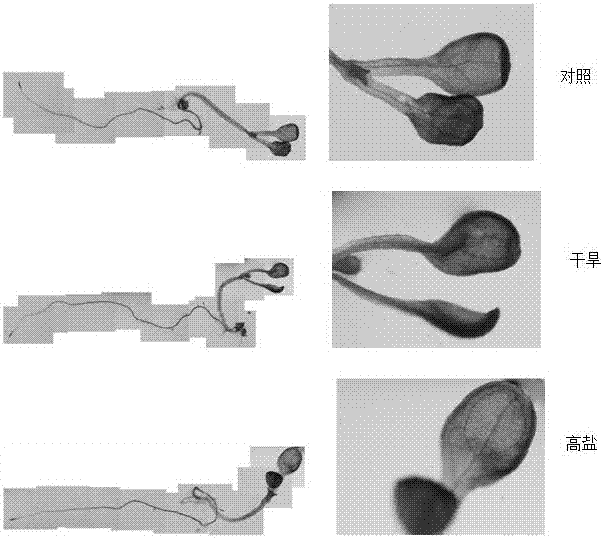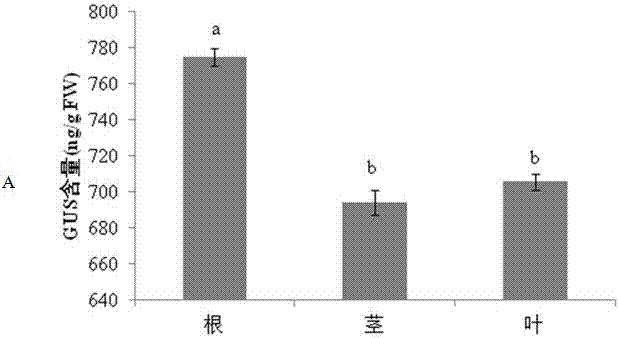Paeonia suffruticosa PsDREB1 gene anti-drought and high salinity promoter and its expression and application
A promoter and anti-drought technology, applied in the field of plant genetic engineering research, can solve problems such as unclear mechanism of action
- Summary
- Abstract
- Description
- Claims
- Application Information
AI Technical Summary
Problems solved by technology
Method used
Image
Examples
Embodiment 1
[0027] Example 1 Cloning of PsDREB1 promoter sequence DREBP in tree peony
[0028] In January 2016, the young leaves of the 3-year-old peony variety 'Luoyanghong' were taken as materials, and the total DNA was extracted using the Trizol kit produced by Omega Company, which was used as a template. According to the full-length sequence of PsDREB1 gene, design reverse primers SP1-CAACAGAAGGGGATCAGCGAAG (SEQ ID NO: 2), SP2-CTTTGGTTTTACCCTCTTGCTCGT (SEQ ID NO: 3), SP3-CGGATTTCTCATTTTCCCATTTC (SEQ ID NO: 4), using Genome Walking of TaKaRa Company Kit (Code No.6108), react with the above template. A product of about 2 kb in size was obtained by PCR amplification.
[0029] The above PCR product was recovered by using Takara’s Mini BEST Aragrose Gel DNA Extraction Kit Ver 4.0 (Code No. 9762) and named P1.
[0030] Using Solution I in TaKaRa's DNA Ligation Kit (Code No.6022), connect the P1 product to pMD 19-T Vector (Code No.6013), and thermally transform it into E.coli Competent Cel...
Embodiment 2
[0035] Example 2 Construction of recombinant vector pBI121-DREBP-GUS
[0036] Preparation of Insert DNA (target DNA): Using the promoter DREBP plasmid obtained above as a template, use the primer pair F2 (SEQ ID NO: 7) / R2 (SEQ ID NO: 8) using Takara’s PrimeSTAR ®® HS (Premix) (CodeNo. R040A) for PCR amplification, the amplification system is: DREBP plasmid (50-fold dilution) 1 μl, F2 (20 pmol / μl) 0.5 μl, R2 (20 pmol / μl) 0.5 μl, Prime STAR HS (Premix) 25 μl, add dH2O to 50 μl; reaction conditions: 98°C for 10s, 55°C for 15s, 72°C for 90s, a total of 30 cycles. Take 5 μl of the PCR product for agarose gel electrophoresis, and use Takara MiniBEST Agarose Gel DNA Extraction Kit Ver.4 .0 (Code No. 9762) to cut the gel to recover the target fragment, named Insert DNA.
[0037] Preparation of Vector DNA (carrier DNA): Using plasmid pBI121 as a template, use restriction endonucleases Hind III and XbaI for double enzyme digestion. The enzyme digestion reaction system is: pBI121 plasm...
Embodiment 3
[0039] Example 3 Genetic Transformation
[0040] The recombinant vector plasmid constructed above was transformed into Agrobacterium GV3101 by electroporation method, and then transformed into Arabidopsis thaliana by flower dipping method reported by Clough and Bent (1998). The F1 generation seeds of Arabidopsis transformed seedlings were collected, and the primary screening culture was carried out on 1 / 2 MS medium containing 40 mg / L kanamycin (Kan). The positive plants screened were then tested using the primer pair VP1 / VP2. For PCR identification, the plants identified as positive were continued to be planted to collect F2 generation seeds. Continue the above method to continue to obtain homozygous F3 generation seeds.
PUM
 Login to View More
Login to View More Abstract
Description
Claims
Application Information
 Login to View More
Login to View More - R&D
- Intellectual Property
- Life Sciences
- Materials
- Tech Scout
- Unparalleled Data Quality
- Higher Quality Content
- 60% Fewer Hallucinations
Browse by: Latest US Patents, China's latest patents, Technical Efficacy Thesaurus, Application Domain, Technology Topic, Popular Technical Reports.
© 2025 PatSnap. All rights reserved.Legal|Privacy policy|Modern Slavery Act Transparency Statement|Sitemap|About US| Contact US: help@patsnap.com



